
Otto Johann Anton Skorzeny was an Austrian-born German SS-Obersturmbannführer in the Waffen-SS during World War II. During the war, he was involved in a number of operations, including the removal from power of Hungarian Regent Miklós Horthy and the Gran Sasso raid which rescued Benito Mussolini from captivity. Skorzeny led Operation Greif in which German soldiers infiltrated Allied lines wearing their opponents' uniforms. As a result, he was charged in 1947 at the Dachau Military Tribunal with breaching the 1907 Hague Convention, but was acquitted.

Audie Leon Murphy was an American soldier, actor, and songwriter. He was widely celebrated as the most decorated American combat soldier of World War II, and has been described as the most highly decorated soldier in U.S. history. He received every military combat award for valor available from the United States Army, as well as French and Belgian awards for heroism. Murphy received the Medal of Honor for valor that he demonstrated at the age of 19 for single-handedly holding off a company of German soldiers for an hour at the Colmar Pocket in France in January 1945, before leading a successful counterattack while wounded and out of ammunition.

A caravanserai was a roadside inn where travelers (caravaners) could rest and recover from the day's journey. Caravanserais supported the flow of commerce, information and people across the network of trade routes covering Asia, North Africa and Southeast Europe, most notably the Silk Road. Often located along rural roads in the countryside, urban versions of caravanserais were also historically common in cities throughout the Islamic world, and were often called other names such as khan, wikala, or funduq.

Night Passage is a 1957 American Western film directed by James Neilson and starring James Stewart and Audie Murphy.
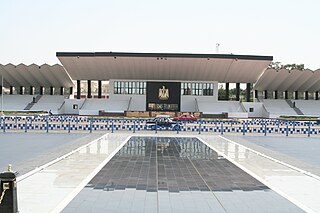
Terrorism in Egypt in the 20th and 21st centuries has targeted the Egyptian government officials, Egyptian police and Egyptian army members, tourists, Sufi Mosques and the Christian minority. Many attacks have been linked to Islamic extremism, and terrorism increased in the 1990s when the Islamist movement al-Gama'a al-Islamiyya targeted high-level political leaders and killed hundreds – including civilians – in its pursuit of implementing traditional Sharia law in Egypt.
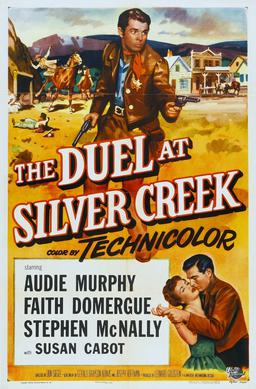
The Duel at Silver Creek is a 1952 American Western film directed by Don Siegel; his first film in the Western genre. It starred Stephen McNally, Audie Murphy and Faith Domergue. It was the first time Murphy had appeared in a film where he played a character who was good throughout the movie. The working titles of the film were Claim Jumpers and Hair Trigger Kid.

Battle at Bloody Beach,, is a 1961 American CinemaScope drama war film directed by Herbert Coleman and starring Audie Murphy who had previously worked together in Posse from Hell. The film also features Gary Crosby and introduces Alejandro Rey. Battle at Bloody Beach is only the second Audie Murphy movie set in World War II, after his autobiographical To Hell and Back. The film was shot on Santa Catalina Island by Robert Lippert's Associated Producers Incorporated and was released by 20th Century Fox. The film was produced and co-written by Richard Maibaum along with frequent Audie Murphy collaborator Willard W. Willingham.
Operation Damocles was a covert campaign of the Israeli intelligence agency, Mossad in August 1962 which targeted German scientists and technicians, formerly employed in Nazi Germany's rocket program, who were developing rockets for Egypt at a military site known as Factory 333. According to Otto Joklik, an Austrian scientist involved with the project, the rockets being developed were programmed to use radioactive waste.

Elana Eden is an Israeli actress of film, television, and stage, best known for her film debut as the title role in 20th Century Fox's biblical epic The Story of Ruth (1960).
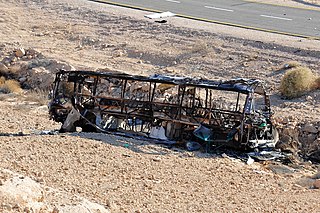
On August 18, 2011, a series of cross-border attacks with parallel attacks and mutual cover was carried out in southern Israel on Highway 12 near the Egyptian border by a squad of presumably twelve militants in four groups. The attacks occurred after Israel's interior security service Shin Bet had warned of an attack by militants in the region and Israeli troops had been stationed in the area. The militants first opened fire at an Egged No. 392 bus as it was traveling on Highway 12 in the Negev near Eilat. Several minutes later, a bomb was detonated next to an Israeli army patrol along Israel's border with Egypt. In a third attack, an anti-tank missile hit a private vehicle, killing four civilians. Eight Israelis – six civilians, one Yamam special unit police sniper and one Golani Brigade soldier—were killed in the multiple-stage attack. The Israel Defense Forces reported eight attackers killed, and Egyptian security forces reported killing another two.
John A. Bolger Jr. was an American sound engineer. He was nominated for an Academy Award in the category Best Sound for the film The Hindenburg.
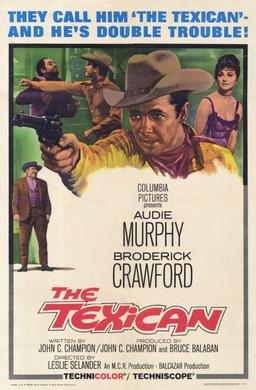
The Texican is a 1966 American Techniscope Western film produced and written by John C. Champion and directed by Lesley Selander. It is a paella western remake of their 1948 film Panhandle adapted for the persona of Audie Murphy that featured Broderick Crawford as the heavy. The film was re-titled Ringo il Texano in Italy to coincide with the popularity of the Ringo Spaghetti Western film series.

Gunfight at Comanche Creek is a 1963 American Western film directed by Frank McDonald and starring Audie Murphy.

The Quick Gun is a 1964 American Techniscope Western film directed by Sidney Salkow and starring Audie Murphy. It was the second of four films produced by Grant Whytock and Edward Small's Admiral Pictures in the 1960s.

Bullet for a Badman is a 1964 American Western film directed by R. G. Springsteen and starring Audie Murphy and Darren McGavin. The film is based on the 1958 novel Renegade Posse by Marvin H. Albert. The film was shot between October and November 1963 in Zion National Park and Snow Canyon State Park in Utah.

Audie Murphy was one of the most decorated United States Army combat soldiers of World War II, serving from 1942 to 1945. He received every American combat award for valor available at the time of his service, including the Medal of Honor. He also received recognitions from France and Belgium. With his 1945 military discharge at the end of the war, Murphy became an advocate of treatment for post-traumatic stress disorder in veterans. The Audie L. Murphy Memorial VA Hospital in San Antonio and the Sergeant Audie Murphy Clubs (SAMC) on military bases honor his contributions. He joined the Texas National Guard in 1950, transferring to reserve status in 1956 and remaining in the Guard until 1969. He also had a civilian career as a film actor and songwriter. Recognitions he received both during his lifetime and posthumously are listed below.
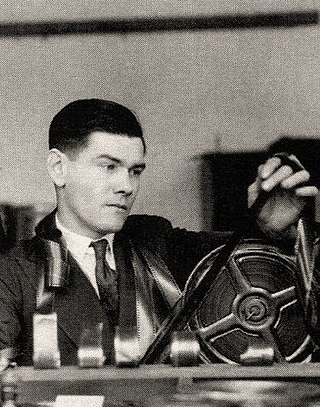
Grant Alexander Whytock was an American film editor and producer who worked on more than 80 films.
Mordechai Ben Masoud Louk was an Israeli adventurer who was convicted by Israeli courts to 10 years in prison for spying for Egypt. He came to the focus of international attention when he was discovered by Italian authorities at the Rome airport, bound, gagged, drugged and packed in a trunk being sent to Cairo as diplomatic mail. In Rome Louk admitted to having "spied" for Egypt and was extradited to Israel on Israel's request.
Marina Orschel is a German actress and beauty pageant titleholder who was crowned Miss Germany 1955 and represented her country at Miss Universe 1955 where she placed 1st Runner-Up. At first her measurements were announced as 36-22-34 inches (91-56-86 cm), but she handed a measuring tape to Miss England and corrected them to 40-27-34 inches (102–69–86 cm). Following these successes, she, Ingrid Goude, and Carol Morris were offered contracts by Universal Pictures, though Orschel's screen appearances are mainly in German films.

Charles Richard Garland Jr. was an American film, stage and television actor, who portrayed Constable Clay Horton in the popular CBS television series Lassie from 1954 to 1956.















